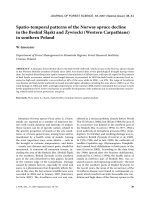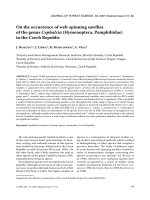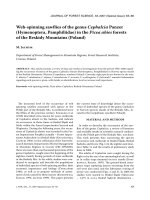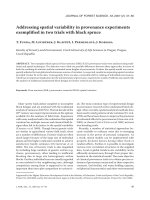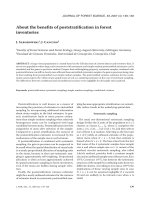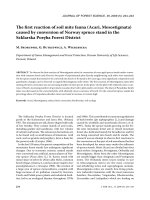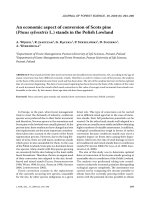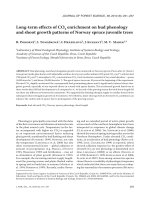Báo cáo lâm nghiệp: "Assimilation apparatus variability of beech transplants grown in variable light conditions of blue spruce shelter O. Špulák" ppsx
Bạn đang xem bản rút gọn của tài liệu. Xem và tải ngay bản đầy đủ của tài liệu tại đây (217.46 KB, 6 trang )
J. FOR. SCI., 54, 2008 (11): 491–496 491
JOURNAL OF FOREST SCIENCE, 54, 2008 (11): 491–496
Admission of light is one of the factors affecting
the forest regeneration quantity and the growth.
Apart from the yew and fir, the beech is one of the
tree species rather tolerant to shade. e shade toler-
ance is particularly important during juvenile stages,
because juveniles in the understorey are likely to
be subject to the shade suppression (P 1997).
Juvenile beeches can quickly adapt their leaf mor-
phology to changes in the light environment, i.e. in
the year following the change (B, S
1965 in P 1997).
One of indirect methods to assess the stand canopy
and the light penetration into forest stands is the
method of the hemisphere sky photograph. The
method dwells on the taking of photographs with a
wide-angle (fish-eye) objective, and on the process-
ing of the photograph and calculation of a range
of parameters depending on the size, location, and
character of gaps in forest stands (see details in R
1990; F et al. 1997, 1999, etc.). e results
of the evaluation of the light conditions by using
this method strongly correlate e.g. with the values
obtained from photodiodes (% of photosynthetic
proton flux density – B et al. 2003) and by
pyranometers (H et al. 2004).
For the survival and growth of tree species, the de-
gree of illumination must be above the compensation
point of photosynthesis (S, C-
2001). e value of this compensation point
depends not only on the plant species and its general
light requirements, but also on the degree of matu-
rity of a concrete assimilatory organ and its accom-
modation to the light conditions in the dependence
on the developmental stage of the individual and on
Supported by the Ministry of Agriculture of the Czech Republic, Project No. MZe 0002070201.
Assimilation apparatus variability of beech transplants
grown in variable light conditions of blue spruce shelter
O. Š
Forestry and Game Management Research Institute, Strnady, Opočno Research Station,
Opočno, Czech Republic
ABSTRACT: e paper valuates the differences in the selected characteristics of the assimilation apparatus of beech
transplants growing in various light conditions of blue spruce small pole stage in the Jizerské hory Mts. in the Czech
Republic. e leaf area, chemical parameters, and photosynthetic capacity measured by the method of chlorophyll
fluorescence were established. Light conditions of individual beech trees were determined by means of processing a
hemisphere photograph of the crown space. e research revealed a significant trend of decreasing nitrogen content with
increasing irradiance of the beech. e foliage of the sheltered beech trees exhibited higher contents of phosphorus and
potassium. e average specific leaf mass (SLM) of the beech under crowns was lower (0.303 contrary to 0.499 g/dm
2
in gap) and the respective variants did not differ in average leaf size. A significantly higher maximum fluorescence and
a maximum quantum yield (0.854 contrary to 0.803 in gap) were found under crowns. A significant variance was also
observed in the absorption capacity. It follows that the beech showed adaptation to the light conditions defined by its
location within the stand of blue spruce.
Keywords: beech transplants; light; nutrient content of leaves; fluorescence of chlorophyll; leaf area
492 J. FOR. SCI., 54, 2008 (11): 491–496
the impact of other environmental factors. On the
other hand, a high intensity of radiation may lead to
serious changes in the structure and function of the
photosynthetic apparatus that are commonly known
as photoinhibition (Ö 1990) and manifest them
selves in the reduced maximum rate of photosynthe-
sis. e decrease is as a rule fully reversible, although
only after a lapse of several hours or days (G
1998). Photoinhibition particularly shows in plants
adapted to dark. According to some researchers
(E et al. 2004), the beech inclines to photoin-
hibition more than for example the ash. However,
our study did not reveal any negative influence of the
photoinhibition periods on the accumulation of total
biomass in the beech individuals concerned.
e plants are capable of physiological adaptation
to concrete light conditions (T et al. 1997).
Irradiance affects also the shape and size of the as-
similation apparatus of tree species. For example,
H and K (1994) observed dissimi-
lar shapes of irradiated and shaded oak leaves with
the shaded leaves exhibiting approximately a double
size than the sunlit leaves thanks to a higher number
of lobes in the sun leaves reducing the leaf area.
Being measured and analysed adequately, the fluo-
rescence of chlorophyll makes it possible to provide
detail information on what is going on inside the
photosynthetising organism (S 2004).
One of the applications of chlorophyll fluorescence
is monitoring differences in the physiology of the
sun and shade leaves and their adaptation to altered
conditions (G et al. 2000; L
et al. 2000; E et al. 2004). A basis for the
application of this method is the relation of chloro-
phyll fluorescence to the capacity of photosynthesis.
eoretical rudiments of chlorophyll fluorescence
processes at the biological level and the methods of
measuring the chlorophyll fluorescence have been
described in a number of fundamental physiological
works (e.g. L et al. 2005).
e objective of this work is to compare some mor-
phological, chemical and physiological parameters of
the assimilation apparatus of the beech individuals
planted in diverse light conditions within a small
pole stage of a blue spruce stand.
METHODOLOGY
e research into the relation of the light condi-
tions to the characteristics of the assimilation ap-
paratus of the beech underplanted in the stand of
blue spruce was conducted in 2007 on the research
plot Plochý in the Jizerské hory Mts., Czech Republic
(880 m a.s.l., slope 5°, area 0.12 ha, acidic spruce for-
est site type). e stand of blue spruce was planted
in this locality in 1985–1990 as a substitution of
autochthonous species, whose planting at the time
of air-pollution disaster failed. e research plot was
established in 1995 in order to investigate the pos-
sibilities of using the substitutive blue spruce stand
for beech underplanting. e beech was planted in a
pseudoregular arrangement of plants in stand gaps,
on crown borders and under crowns of blue spruce
trees. e stand of blue spruce was not subjected to
any release during the research period.
Preceding works revealed a positive effect of the
blue spruce on the survival of beech individuals
(B, K 2008). In 2006, the average
heights of the blue spruce and the beech on the
research plot were 4 m (Š 2007) and 72 cm
(137 cm for 20% of the highest trees), respectively.
In 2007, leaves were sampled from the upper
crown parts of equably high 10 individuals growing
under the crown of blue spruce and 10 individuals
growing in the gaps. Chlorophyll fluorescence in
the samples was analysed using the Imaging-PAM
Chlorophyll Fluorometer. e total number of leaves
analysed per variant was 44, i.e. 3–5 leaves per trans-
plant. e measurement was made simultaneously
in 2 leaves of each variant. Following the adaptation
of leaves to darkness, maximum fluorescence yield
Fv/Fm and the absorption capacity were measured,
followed by the measurements of rapid kinetics and
light curve (W 2004).
Furthermore, the complete assimilation apparatus
was sampled from 11 approximately average beech
individuals growing under the crown, on the crown
border, and in the gap. e assimilation apparatus
area and the parameters of an average leaf were de-
termined by scanning and analysis using the ImageJ
1.38x programme. e individual 33 samples were
analysed for DM content, the contents of nutrients
(N, P, K, Ca, Mg), sulphur, and silicon.
Concrete crown light conditions of the above
beech trees analysed were established by the method
of hemisphere photograph assessment (e.g. R
1990). e photographs were taken at a hight of
80 cm above the ground at the growth point of the
analysed beech with the image being processed by
the Gap Light Analyser SW (version 2.0, F et
al. 1999).
e data were evaluated by ANOVA and Kruskal-
Wallis tests (at α = 0.05 if not stated otherwise).
RESULTS AND DISCUSSION
e light conditions of the beeches in the respec-
tive variants exhibited statistically significant differ-
J. FOR. SCI., 54, 2008 (11): 491–496 493
ences. Average canopy openness under the crown,
on the crown border, and in the gap was 22.1%,
30.7%, and 53.5%, respectively. With the increasing
irradiance, the share of individuals with the tendency
towards horizontal growth was decreasing. The
Vertical Growth Index trend (ratio between beech
tree height and the length of the longest shoot) was
not conspicuous, though (Fig. 1a). P (1997)
describes two extreme growth strategies of Fagus
sylvatica in the shade: (1) mainly (pseudo)sympodial
branching with long shoots and absent top-shoot,
and (2) a monopodial top-shoot consisting of short
shoots. us, the individuals with the strategy of
short shoots disturb the above characterised trend.
Chemical analysis of the beech assimilation ap-
paratus showed a statistically significant trend of
decreasing nitrogen content in the direction from
individuals growing under crown to individuals
growing in the open (Table 1, Fig. 1b). e trend
corresponds to the findings published in literature
from the research of natural regeneration under
forest stand and in forest stand gap (J et al.
1997). Beech trees growing in the shade exhibited
significantly higher concentrations of phosphorus
and potassium. A similar trend of decreasing con-
centrations with the increasing irradiance was re-
corded with other elements, too (Ca, Mg). e higher
capacity of nutrients accumulation in the assimila-
Fig. 1. Canopy openness relations obtained through the analysis of hemisphere photographs to the selected parameters of
beech assimilation apparatus: a – vertical growth index (ratio of the perpendicular height of beech to the longest shoot length),
b – nitrogen content (%), c – specific leaf mass (g/dm
2
), d – maximum quantum yield of chlorophyll a fluorescence
y = 0.1141Ln(x ) + 0.4487
R
2
= 0.1543
0.00
0.20
0.40
0.60
0.80
1.00
0 20 40 60 80
Canopy openness (%)
Vertical growth index (%)
y = –0.4976Ln(x ) + 3.4822
R
2
= 0.5374
0.00
0.50
1.00
1.50
2.00
2.50
3.00
0 20 40 60 80
Canopy openness (%)
N (%)
y = 0.1738Ln(x ) – 0.1968
R
2
= 0.4767
0
0.2
0.4
0.6
0.8
0 20 40 60 80
Canopy openness (%)
Specific leaf mass (g/dm
2
)
y = –0.0015x + 0.8886
R
2
= 0.3991
0.50
0.60
0.70
0.80
0.90
1.00
0 20 40 60 80
Canopy openness (%)
Fv/Fm
(a)
(d)(c)
(b)
Table 1. Average contents of nutrients in the foliage of beech trees planted under blue spruce crowns, on crown perimeter
and in gaps. Different letter between locations indicates a different group of statistic homogeneity
Location
N P K Ca Mg S Si
Dry matter
(g)
(%)
Crown
mean 2.114a 0.076a 0.575a 0.971 0.194 0.167 0.758a 3.829a
s. d. 0.167 0.024 0.079 0.260 0.046 0.031 0.312 2.910
Perimeter
mean 1.703b 0.043b 0.415b 0.819 0.180 0.139 0.374b 4.111ab
s. d. 0.237 0.019 0.085 0.133 0.050 0.022 0.181 2.370
Gap
mean 1.517c 0.038b 0.368b 0.797 0.163 0.162 0.520ab 7.742b
s. d. 0.090 0.016 0.047 0.204 0.042 0.074 0.264 4.520
R
2
R
2
R
2
R
2
494 J. FOR. SCI., 54, 2008 (11): 491–496
tory organs of sheltered beech trees is a prerequisite
for their faster recycling by leaf-fall.
In the case of silicon, a statistic difference was
observed between the under-crown variant and the
crown-border variant. e markedly higher values in
the crown may be caused by the spruce canopy drift
as it is well known that spruce needles, particularly
if the spruce is under stress, have a higher content of
silicon (G et al. 1991). e beech trees grow-
ing in the respective variants differed by neither
average height nor their average leaf area, showed a
convincing gradient (Table 2); statistically significant
was however the difference in the DM content of the
assimilatory organs, the weight of which was increas-
ing with the increasing irradiance (Table 1). is cor-
responds to the findings published by M et
al. (1998), who recorded in the research into natural
regeneration that the specific weight of the beech
as well as those of Fraxinus excelsior and Carpinus
betulus were highest in the sunlit clearcut and lowest
in the understory. is also corresponds to the ratio
of the leaf area to the beech tree height in the case of
the under-crown and in-gap variants (Table 2).
e average leaf size of the beech trees growing
under crown and in gap was comparable; average
leaf area did not exhibit any statistically significant
difference between the variants (Table 2). In contrast
to this, M (1989) observed in mature beech in-
dividuals the area of shade leaves larger by 20% than
that of sunlit leaves. Significantly larger but thinner
shade leaves in the mature beech were reported also
by H and Č (2005). e leaf thick-
ness was not measured in our study. However, the
comparison of average leaf dry weight points to a
significantly lower weight of leaves as well as the
weight of the square decimetre (Specific Leaf Mass)
of beech leaves growing under crowns (Table 3, Fig.
1c), which can be considered an indication of the leaf
thickness differences, too.
Comparing the basic parameters of chlorophyll
fluorescence, we found highly significant differences
between the under-crown and in-the-open variants
(Table 4). e shaded individuals exhibited both a
higher maximum fluorescence and the Fv/Fm ratio
(maximum quantum yield), which corresponds to
the findings in adult (H, Č 2005).
e decreasing maximum quantum yield with the
increasing irradiance can be expressed by a linear
trend (Fig. 1d). e respective variants also differed
in their capacity of absorption – the ratio of reflected
R and NIR radiation. Absorptivity measured by the
Imaging-PAM instrument may be considered a close
estimate of PAR-Absorptivity (W 2004).
Table 2. Leaf area parameters, the average height of beech trees and the leaf area/height ratio
Location
Mean leaf
(cm
2
)
Mean total leaf area
(cm
2
)
Mean height
(cm)
Leaf area/height ratio
Crown
mean 7.28 1,321.7 63.9 18.6
s. d. 1.55 1,094.0 24.4 11.2
Perimeter
mean 7.64 1,066.6 61.5 17.0
s. d. 1.95 663.4 16.0 8.3
Gap
mean 7.42 1,572.8 71.1 21.1
s. d. 1.86 878.8 17.3 8.2
Table 3. Dry weight of average leaf and dry specific
leaf mass (SLM) in beeches planted under blue spruce
crowns, on crown perimeter and in gaps. Different letter
between locations indicates a different group of statistic
homogeneity
Location
Mean dry matter
weight of leaf
(g)
Specific leaf
mass
(g/dm
2
)
Crown
mean 0.0221a 0.303a
s. d. 0.0058 0.043
Perimeter
mean 0.0289bc 0.400b
s. d. 0.0057 0.078
Gap
mean 0.0362c 0.499c
s. d. 0.0101 0.110
Table 4. Minimum and maximum fluorescence, maximal
fluorescence yield and absorptivity (Abs) of the leaves
of beech trees planted under blue spruce crowns and in
gaps
Location F0 Fm** Fv/Fm** Abs*
Crown
mean 0.087 0.594 0.854 0.888
s. d. 0.027 0.099 0.036 0.020
Gap
mean 0.086 0.451 0.803 0.878
s. d. 0.022 0.101 0.075 0.019
**Significance at α = 0.01, *significance at α = 0.05
J. FOR. SCI., 54, 2008 (11): 491–496 495
CONCLUSION
In our research into the impact of the light condi-
tions on the assimilation apparatus characteristics
of the beech underplanted in a blue spruce small
pole stage of about 4 m in height, a significant in-
fluence was observed of the shelter on the selected
parameters. Chemical analysis revealed a statisti-
cally significant trend of decreasing nitrogen content
with increasing irradiance (from 2.1% to 1.5%). e
beech trees growing in the shelter exhibited signifi-
cantly higher phosphorus and potassium contents.
Magnesium and calcium showed a decreasing
trend, which was insignificant though. Average dry
weight of leaves under crowns was significantly
lower than the dry weight of the leaves of the beech
trees growing in gap with the two variants showing
no difference in the leaf size. e beeches growing
under crowns showed significantly higher maximum
fluorescence (0.594 and 0.451) as well as significantly
higher maximum quantum yield (0.854 as compared
with 0.803); absorptivity also exhibited a significant
variance. us, the beech demonstrated its capacity
of adaptation to the light conditions defined by its
location within the blue spruce stand.
Reference s
BALCAR V., KACÁLEK D., 2008. European beech planted
into spruce stands exposed to climatic stresses in mountain
areas. Austrian Journal of Forest Science, 125: 27–38.
BATTAGLIA M.A., MITCHELL R.J., MOU P.P., PECOT
S.D., 2003. Light transmittance estimates in a longleaf pine
woodland. Forest Science, 49: 752–762.
EINHORN K.S., ROSENQVIST E., LEVERENZ J.W., 2004.
Photoinhibition in seedlings of Fraxinus and Fagus under
natural light conditions: implications for forest regenera-
tion? Oecologia, 140: 241–251.
FRAZER G.W., TROFYMOW J.A., LETZMAN K.P., 1997.
A method for estimating canopy openness, effective leaf
area index, and photosynthetically active photon flux den-
sity using hemispherical photography and computerized
image analysis techniques. Canadian Forest Service, Forest
Ecosystem Processes Network: 81.
FRAZER G.W., CANHAM C.D., LERTZMAN K.P., 1999.
Gap Light Analyzer (GLA). Imaging software to extract
canopy structure and gap light transmission indices from
true-colour fisheye photographs. Users manual and pro-
gram documentation. Millbrook – New York, Institute of
Ecosystem Studies: 36
GAMPER R., MAYR S., BAUER H., 2000. Similar susceptibil-
ity to excess irradiance in sun and shade acclimated saplings
of Norway spruce (Picea abies (L.) Karst.) and stone pine
(Pinus cembra L.). Photosynthetica, 38: 373–378.
GLOSER J., 1998. Fyziologie rostlin. [Skripta.] Brno, Masa-
rykova univerzita: 157.
GODDE D., DIVOUX S., HÖFERT M., KLEIN C., GONSIOR
B., 1991. Quantitative and localized element analysis in
cross-sections of spruce (Picea abies (L.) Karst.) needles
with different degrees of damage. Trees: Structure and
Function, 5: 95–100.
HAMERLYNCK E.P., KNAPP A.K., 1994. Leaf-level re-
sponses to light and temperature in two co-occurring
Quercus (Fagaceae) species: implications for tree distri-
bution patterns. Forest Ecology and Management, 68:
149–159.
HARDY J.P., MELLOH R., KOENIG G., MARKS D., WINS-
TRAL A., POMEROY J.W., LINK T., 2004. Solar radiation
transmission through conifer canopies. Agricultural and
Forest Meteorology, 126: 257–270.
HLADKÁ D., ČAŇOVÁ I., 2005. Morphological and physi-
ological parameters of beech leaves (Fagus sylvatica L.) in
research demonstration object Poľana. Journal of Forest
Science, 51: 168–176.
JOHNSON J.D., TOGNETTI R., MICHELOZZI M., PIN-
ZAUTI S., MINOTTA G., BORGHETTI M., 1997. Ecophy-
siological responses of Fagus sylvatica seedlings to chang-
ing light conditions. II. e interaction of light environ-
ment and soil fertility on seedlings physiology. Physiologia
Plantarum, 101: 124–134.
LICHTENTHALER H.K., BABANI F., LANGSDORF G.,
BUSCHMANN C., 2000. Measurement of differences in
red chlorophyll fluorescence and photosynthetic activity
between sun and shade leaves by fluorescence imaging.
Photosynthetica, 38: 521–529.
MAJER A., 1989. Size of beech leaf and variety of its form.
Erdészeti és Faipari Tudományos Közlemények, 1–2:
5–25.
MÉSZÁROS I., TÓTH R.V., VERES S., 1998. Photosynthetic
responses to spatial and diurnal variations of light condi-
tions in seedlings of three deciduous tree species. Photo-
synthesis: mechanisms and effects. Volume V. Proceedings
of the XI
th
International Congress on Photosynthesis, Bu-
dapest, Hungary, 17–22 August 1998. Dordrecht, Kluwer
Academic Publishers: 4081–4084.
ÖGREN E., 1990. Prediction of photoinhibition of photo-
synthesis from measurements of fluorescence quenching
components. Planta, 184: 538–544.
PETERS R., 1997. Beech Forests. Dordrecht, Boston, London,
Kluwer Academic Publishers: 169.
RICH P.M., 1990. 2. Characterizing plant canopies with
hemispherical photographs. Remote Sensing Reviews, 5:
13–29.
SCHREIBER U., 2004. Pulse-Amplitude modulation (PAM)
Fluorometry and Saturation Pulse method: An Overview.
In: PAPAGEORGIOU G.C. (ed.), Chlorophyll a Fluores
-
cence: a Signature of Photosynthesis. Dordrecht, Springer
Verlag: 279–319.
496 J. FOR. SCI., 54, 2008 (11): 491–496
SILVERTOWN J.W., CHARLESWORTH D., 2001. Introduc-
tion to Plant Population Biology. Blackwell Publishing:
347.
ŠPULÁK O., 2007. Impact of extremely snowy winter to Pi-
cea pungens (Engelm.) forest stand on the summit part of
the Jizerské hory Mts. (Czech Republic). In: SANIGA M.,
JALOVIAR P., KUCEL S. (eds), Management of Frests in
Changing Environmental Conditions. Zvolen, Technical
University in Zvolen, Faculty of Forestry: 113–118.
TOGNETTI R., JOHNSON J.D., MICHELOZZI M., 1997.
Ecophysiological responses of Fagus sylvatica seedlings
to changing light conditions. I. Interactions between
photosynthetic acclimation and photoinhibition during
simulated canopy gap formation. Physiologia Plantarum,
101: 115–123.
WALZ Heinz GmbH, 2004. Imaging – PAM Chlorophyll
Fluorometer. Instrument Description and Information for
Users. 2.143 / 02.2003, 4. Ed. February 2004: 134.
Received for publication June 10, 2008
Accepted after corrections July 11, 2008
Corresponding author:
Ing. O Š, Výzkumný ústav lesního hospodářství a myslivosti, v.v.i., Strnady, Výzkumná stanice Opočno,
Na Olivě 550, 517 73 Opočno, Česká republika
tel.: + 420 494 668 392, fax: + 420 494 668 393, e-mail:
Proměnlivost asimilačního aparátu prosadeb buku do porostu smrku
pichlavého rostoucích v různých světelných podmínkách
ABSTRAKT: Příspěvek hodnotí rozdíly ve vybraných charakteristikách asimilačního aparátu sazenic buku, rostou-
cích v různých světelných poměrech tyčkoviny smrku pichlavého v Jizerských horách v České republice. Hodnotila
se listová plocha, chemické parametry a fotosyntetická kapacita metodou měření fluorescence chlorofylu. Světel-
né poměry jednotlivých buků byly stanoveny pomocí zpracování hemisférické fotografie korunového prostoru.
Z výzkumu vyplynul průkazný trend poklesu obsahu dusíku s rostoucí ozářeností buku; listy zastíněných buků měly
vyšší obsah fosforu a draslíku. Průměrná specifická hmotnost listí (SLM) buků rostoucího pod korunami byla nižší
(0,303 proti 0,499 g/dm
2
), velikostí průměrného listu se varianty nelišily. Pod korunou byla zjištěna průkazně vyšší
hodnota maximální fluorescence a maximálního výtěžku fluorescence (0,854 proti 0,803), také v absorptivitě byl
zjištěn významný rozdíl. Buk tak vykazoval adaptaci na světelné podmínky definované jeho polohou vůči prosazo-
vanému porostu smrku pichlavého.
Klíčová slova: buková prosadba; světlo; obsah živin v listech; fluorescence chlorofylu; listová plocha

